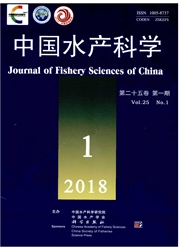

 中文摘要:
中文摘要:
以雌褐牙鲆(Paralichthys olivaceus)、雄夏鲆(P. dentatus)及其子一代为研究对象,对其核糖体基因的ITS1序列进行比较分析。结果表明, ITS1序列具有明显的种间及个体内差异。在雄夏鲆ITS1序列中仅发现1种基因类型(X 型),而在雌褐牙鲆及子一代 ITS1序列中发现两种差异显著的基因型(X型和 Y 型)。在亲本中未检测到两种类型的交换重组序列,而在子代中检测到4个X型与Y型的重组序列,说明子代ITS1区域更容易发生交换重组。进一步的遗传距离分析发现,母本与子代之间的遗传距离(0.059)明显大于父本与子代之间的遗传距离(0.018),且子代中 X 型片段出现的频率(85.5%)远大于 Y 型片段出现频率(8.7%),表明亲本双方 ITS1区域的遗传信息都遗传给了子代并且 X 型片段的遗传信息明显占有优势,进而从分子水平上证明子代为褐牙鲆与夏鲆的杂交后代。本研究旨在分析牙鲆属亲本及子代的ITS1序列特征,为鱼类核糖体基因的研究积累数据。
 英文摘要:
英文摘要:
Ribosomal DNA is considered one of the most useful markers for comparative evolutionary and phylogenetic studies. In this study, the first internal transcribed spacer (ITS1) region was analyzed using female Paralichthys oliva-ceus, male Paralichthys dentatus and their hybrids to explore their genetic characteristics. The results indicated that the intraindividual and interspecific polymorphism levels in ITS1 were significant. Only one genotype (Type X) was de-tected in the P. dentatus ITS1 sequences, while two distinct genotypes (Type X and Y) were present in P. olivaceus and the hybrids. No recombinants were identified in the parental ITS1 sequences. However, four type X and Y sequence recombinants were identified in the hybrids, suggesting that there was a higher likelihood of forming recombinants in the hybrids than in the parental ITS1 sequences. Further analyses using Kimura 2-parameter distance showed that the genetic distance between the hybrids and P. olivaceus (0.059) was larger than that between the hybrids and P. dentatus (0.018). In the hybrids, the frequency of Type X (85.5%) was considerably larger than that of Type Y (8.7%), indicating that the genetic material from both the male and the female parent was inherited by the offspring and that from the male parent had a considerable advantage. Hence, the molecular evidence indicates that the offspring were derived from hy-bridization between P. olivaceus and P. dentatus, rather than from any other breeding method. This study aimed at ana-lyzing the polymorphism of ITS1 sequences and providing useful data for fish ribosomal DNA.
 同期刊论文项目
同期刊论文项目
 同项目期刊论文
同项目期刊论文
 期刊信息
期刊信息
